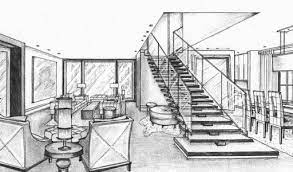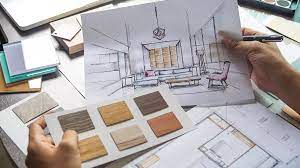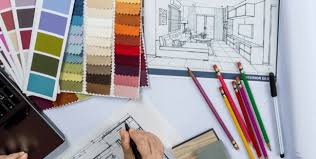Which Course is Best for Interior Design? Do Interior Designers Need Maths?
Interior Design:
Interior design is the art and science of enhancing the interior of a space to create a functional and aesthetically pleasing environment. It involves the design of a space’s layout, color scheme, lighting, furniture, and accessories to create an environment that is both visually appealing and practical for the people who use it.
Interior designers work with clients to understand their needs, preferences, and budget, and then develop a design plan that meets those requirements. This can involve selecting and arranging furniture, choosing color palettes, selecting and installing lighting fixtures, and adding decorative elements such as artwork or plants.

The goal of interior design is to create a space that is not only visually appealing but also functional and comfortable for its occupants. Interior designers must consider factors such as the purpose of the space, the flow of traffic through the space, and the practical requirements of the people who will use it.
Interior design is a diverse field, and interior designers can work on a wide range of projects, including residential homes, commercial spaces, hospitality venues, and public spaces. They may work independently or as part of a design team, and they may specialize in specific areas such as sustainable design or historic preservation.
Which Course is Best for Interior Design?
Interior design is a fascinating and creative field that involves designing and decorating interior spaces to create a comfortable, functional, and aesthetically pleasing environment. If you are interested in pursuing a career in interior design, there are various courses available that can help you acquire the necessary knowledge and skills.

Here are some of the best courses for interior design:
- Bachelor of Fine Arts in Interior Design A Bachelor of Fine Arts (BFA) degree in interior design is an excellent choice for students who want to study the technical aspects of design, including space planning, color theory, furniture design, and lighting. The program typically takes four years to complete, and it provides students with a strong foundation in the principles of design, as well as hands-on experience in design studios.
- Diploma in Interior Design A Diploma in Interior Design is a shorter course that typically takes one to two years to complete. It is an excellent option for students who want to gain practical skills in interior design without committing to a longer program. The course covers topics such as design software, drafting, and project management, and it provides students with a solid understanding of the design process.
- Master of Interior Design A Master of Interior Design is a postgraduate program that provides students with an in-depth understanding of design theory and practice. The course typically takes two years to complete and includes modules in research, design methodology, and project management. It is an excellent option for students who want to specialize in a particular area of interior design, such as sustainable design or lighting design.
- Certificate Course in Interior Design A certificate course in interior design is a short-term course that typically lasts between six months to a year. It is an excellent option for students who want to gain practical skills in a specific area of interior design, such as kitchen design or furniture design. The course covers topics such as space planning, color theory, and materials, and it provides students with a solid foundation in the principles of design.
- Online Courses in Interior Design There are various online courses available for students who want to study interior design from the comfort of their homes. These courses are typically self-paced and cover topics such as design software, color theory, and space planning. Online courses are an excellent option for students who want to gain practical skills in interior design while working full-time or studying in a different field.

In conclusion, choosing the best course for interior design depends on your career goals, budget, and time commitment. A Bachelor of Fine Arts in Interior Design or a Master of Interior Design is an excellent option for students who want to gain in-depth knowledge and skills in the field, while a certificate or diploma course in interior design is a great choice for those who want to gain practical skills quickly. Whatever course you choose, make sure to research the program thoroughly to ensure it aligns with your career goals and interests.
Do Interior Designers Need Maths?
Yes, interior designers need math skills in their profession. Math is an essential component of interior design, and designers use it to perform various tasks such as calculating dimensions, measurements, and proportions of a space. Interior designers must have a strong understanding of math concepts, such as geometry and algebra, to create accurate designs and ensure that they are functional and safe.

Interior designers use math to:
- Calculate dimensions: Interior designers use math to measure the dimensions of a space accurately. They need to calculate the length, width, and height of the room to create accurate drawings and models.
- Determine materials needed: Interior designers use math to determine the amount of materials needed for a project. They need to calculate the square footage of a room to determine how much paint, flooring, or wallpaper is needed.
- Calculate costs: Interior designers use math to calculate the costs of a project. They need to estimate the cost of materials and labor to provide accurate quotes to clients.
- Create blueprints: Interior designers use math to create accurate blueprints and drawings. They need to calculate the scale of a drawing to ensure that the design will fit in the space.
- Ensure safety: Interior designers use math to ensure that a space is safe. They need to calculate the weight capacity of furniture and fixtures to ensure that they will not cause damage or injury.

In conclusion, math is a crucial skill for interior designers, and it is essential for them to have a strong understanding of math concepts to create accurate, functional, and safe designs. Interior designers must be proficient in geometry, algebra, and other math concepts to succeed in their profession.
Interior Design:
Interior design is the art and science of enhancing the interior of a space to create a functional and aesthetically pleasing environment. It involves the design of a space’s layout, color scheme, lighting, furniture, and accessories to create an environment that is both visually appealing and practical for the people who use it.
Interior designers work with clients to understand their needs, preferences, and budget, and then develop a design plan that meets those requirements. This can involve selecting and arranging furniture, choosing color palettes, selecting and installing lighting fixtures, and adding decorative elements such as artwork or plants.
The goal of interior design is to create a space that is not only visually appealing but also functional and comfortable for its occupants. Interior designers must consider factors such as the purpose of the space, the flow of traffic through the space, and the practical requirements of the people who will use it.
Interior design is a diverse field, and interior designers can work on a wide range of projects, including residential homes, commercial spaces, hospitality venues, and public spaces. They may work independently or as part of a design team, and they may specialize in specific areas such as sustainable design or historic preservation.
Which Course is Best for Interior Design?
Interior design is a fascinating and creative field that involves designing and decorating interior spaces to create a comfortable, functional, and aesthetically pleasing environment. If you are interested in pursuing a career in interior design, there are various courses available that can help you acquire the necessary knowledge and skills.
Here are some of the best courses for interior design:
- Bachelor of Fine Arts in Interior Design A Bachelor of Fine Arts (BFA) degree in interior design is an excellent choice for students who want to study the technical aspects of design, including space planning, color theory, furniture design, and lighting. The program typically takes four years to complete, and it provides students with a strong foundation in the principles of design, as well as hands-on experience in design studios.
- Diploma in Interior Design A Diploma in Interior Design is a shorter course that typically takes one to two years to complete. It is an excellent option for students who want to gain practical skills in interior design without committing to a longer program. The course covers topics such as design software, drafting, and project management, and it provides students with a solid understanding of the design process.
- Master of Interior Design A Master of Interior Design is a postgraduate program that provides students with an in-depth understanding of design theory and practice. The course typically takes two years to complete and includes modules in research, design methodology, and project management. It is an excellent option for students who want to specialize in a particular area of interior design, such as sustainable design or lighting design.
- Certificate Course in Interior Design A certificate course in interior design is a short-term course that typically lasts between six months to a year. It is an excellent option for students who want to gain practical skills in a specific area of interior design, such as kitchen design or furniture design. The course covers topics such as space planning, color theory, and materials, and it provides students with a solid foundation in the principles of design.
- Online Courses in Interior Design There are various online courses available for students who want to study interior design from the comfort of their homes. These courses are typically self-paced and cover topics such as design software, color theory, and space planning. Online courses are an excellent option for students who want to gain practical skills in interior design while working full-time or studying in a different field.
In conclusion, choosing the best course for interior design depends on your career goals, budget, and time commitment. A Bachelor of Fine Arts in Interior Design or a Master of Interior Design is an excellent option for students who want to gain in-depth knowledge and skills in the field, while a certificate or diploma course in interior design is a great choice for those who want to gain practical skills quickly. Whatever course you choose, make sure to research the program thoroughly to ensure it aligns with your career goals and interests.
BDo Interior Designers Need Maths?
Yes, interior designers need math skills in their profession. Math is an essential component of interior design, and designers use it to perform various tasks such as calculating dimensions, measurements, and proportions of a space. Interior designers must have a strong understanding of math concepts, such as geometry and algebra, to create accurate designs and ensure that they are functional and safe.

Interior designers use math to:
- Calculate dimensions: Interior designers use math to measure the dimensions of a space accurately. They need to calculate the length, width, and height of the room to create accurate drawings and models.
- Determine materials needed: Interior designers use math to determine the amount of materials needed for a project. They need to calculate the square footage of a room to determine how much paint, flooring, or wallpaper is needed.
- Calculate costs: Interior designers use math to calculate the costs of a project. They need to estimate the cost of materials and labor to provide accurate quotes to clients.
- Create blueprints: Interior designers use math to create accurate blueprints and drawings. They need to calculate the scale of a drawing to ensure that the design will fit in the space.
- Ensure safety: Interior designers use math to ensure that a space is safe. They need to calculate the weight capacity of furniture and fixtures to ensure that they will not cause damage or injury.

In conclusion, math is a crucial skill for interior designers, and it is essential for them to have a strong understanding of math concepts to create accurate, functional, and safe designs. Interior designers must be proficient in geometry, algebra, and other math concepts to succeed in their profession.








